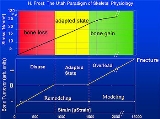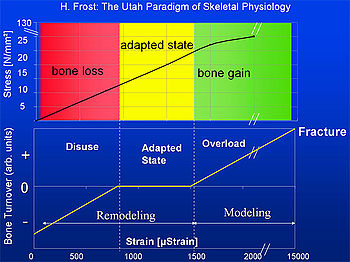
Mechanostat
Encyclopedia
The Mechanostat is a model describing bone growth and bone loss. It was promoted by Harold Frost
and described extensively in the Utah Paradigm of Skeletal Physiology in the 1960’s. The Mechanostat is a refinement of Wolff's law
described by Julius Wolff
(1836-1902).
According to the Mechanostat bone growth and bone loss is stimulated by the local mechanical elastic deformation of bone. The reason for the elastic deformation of bone is the peak forces caused by muscles (e.g. measurable using mechanography
). The Adaptation (feed-back control loop) of bone according to the maximum forces is considered to be a life-long process. Hence bone adapts its mechanical properties according to the needed mechanical function – bone mass, bone geometry and hence bone strength
(see also Stress-strain index
, SSI) is adapted according to the every-day usage / needs.
Due to this control loop there is a linear relationship in the healthy body between muscle cross sectional area (as a surrogate for typical maximum forces the muscle is able to produce under physiological conditions) and the bone cross sectional area (as a surrogate for bone strength).
These relations are of immense importance especially for bone loss situations like in osteoporosis
, since an adapted training utilizing the needed maximum forces on the bone can be used to stimulate bone growth and hence prevent or help to minimize bone loss. An example for such an efficient training is vibration training or whole body vibration
.

According to this a typical bone, e.g. the tibia
has a security margin of about 5 to 7 between typical load (2000 to 3000 μStrain) and fracture load (about 15000μStrain).
It has to be considered that bone strength is highly dependent on geometry and direction of the acting forces in relation to this geometry. The fracture load for axial forces of the tibia for example is about 50 to 60 times the body weight. The fracture load for forces perpendicular to the axial direction is about 10 times lower.
Different type of bones can have different modelling and remodelling thresholds. The modeling threshold of the tibia is about 1500μStrain (= 0,15% change of length), the modelling threshold for bone of the skull is lowered by the factor of 6 to 8. Since the physical material properties of bone (as a material) are not altered in the different bone types of the body, this difference in modelling threshold results in an increased bone mass and bone strength and hence in an increased safety factor (relation between fracture load and typical loads) for the skull compared to the tibia. A lower modeling threshold means that the same typical daily forces result in a ‘thicker’ and hence stronger bone at the skull.
due to an accident.
For example a patient in a wheel chair who is using his arms but due to his paraplegia not his legs will suffer massive muscle and bone loss only in his legs due to the lack of usage of the legs. However the muscles and bones of the arms which are used every day will stay the same or might even be increased depending on the usage.
The same effect can be observed for long flight Astronauts or CosmonautsBlottner D., Salanova M., Püttmann B., Schiffl G., Felsenberg D., Buehring B., Rittweger J.: Human skeletal muscle structure and function preserved by vibration muscle exercise following 55 days of bed rest
, Eur J. Appl Physiol, 2006, Vol. 97, S. 261-271, PMID 16568340. While they still use their arms in an almost normal manner due to the lack of gravity in space there are no maximum forces induced on the bones of the legs.
Harold Frost
Harold M. Frost was an US-American orthopedist and surgeon considered to be one of the most important researchers and theorists in the field of bone biology and bone medicine of his time...
and described extensively in the Utah Paradigm of Skeletal Physiology in the 1960’s. The Mechanostat is a refinement of Wolff's law
Wolff's law
Wolff's law is a theory developed by the German Anatomist/Surgeon Julius Wolff in the 19th century that states that bone in a healthy person or animal will adapt to the loads it is placed under. If loading on a particular bone increases, the bone will remodel itself over time to become stronger...
described by Julius Wolff
Julius Wolff
Julius Wolff was a German surgeon.-Biography:Julius Wolff was born on March 21, 1836, and received his doctorate in 1860 in the field of surgery for Bernhard von Langenbeck at the Friedrich-Wilhelms University to Berlin. In 1861 he settled down after the state examination as a general...
(1836-1902).
According to the Mechanostat bone growth and bone loss is stimulated by the local mechanical elastic deformation of bone. The reason for the elastic deformation of bone is the peak forces caused by muscles (e.g. measurable using mechanography
Mechanography
Mechanography is a medical diagnostic measurement method for motion analysis by means of physical parameters. The variation of the ground reaction forces over the time of a motion like typical every day movements Mechanography (also referred to as jumping mechanography) is a medical diagnostic...
). The Adaptation (feed-back control loop) of bone according to the maximum forces is considered to be a life-long process. Hence bone adapts its mechanical properties according to the needed mechanical function – bone mass, bone geometry and hence bone strength
Strength of materials
In materials science, the strength of a material is its ability to withstand an applied stress without failure. The applied stress may be tensile, compressive, or shear. Strength of materials is a subject which deals with loads, deformations and the forces acting on a material. A load applied to a...
(see also Stress-strain index
Stress-strain index
The stress–strain index , of a bone, is a surrogate measure of bone strength determined from a cross-sectional scan by QCT or pQCT...
, SSI) is adapted according to the every-day usage / needs.
Due to this control loop there is a linear relationship in the healthy body between muscle cross sectional area (as a surrogate for typical maximum forces the muscle is able to produce under physiological conditions) and the bone cross sectional area (as a surrogate for bone strength).
These relations are of immense importance especially for bone loss situations like in osteoporosis
Osteoporosis
Osteoporosis is a disease of bones that leads to an increased risk of fracture. In osteoporosis the bone mineral density is reduced, bone microarchitecture is deteriorating, and the amount and variety of proteins in bone is altered...
, since an adapted training utilizing the needed maximum forces on the bone can be used to stimulate bone growth and hence prevent or help to minimize bone loss. An example for such an efficient training is vibration training or whole body vibration
Whole body vibration
Whole body vibration , as a therapy, was explored by Russian scientist Vladimir Nazarov, who tested vibration on cosmonauts in an effort to decrease the loss of muscle and bone mass in space. As there is minimal gravitational force in space, muscles and bones are not loaded as they normally are on...
.
Modeling and Remodeling
Frost defined four regions of elastic bone deformation which result in different consequences on the control loop:
- Disuse:
Strain < circa 800μStrain: Remodeling (bone adaptation and bone repair) Bone mass and bone strength is reduced. - Adapted State:
strain between ca. 800μStrain and ca. 1500μStrain: Remodeling (bone repair) Bone mass and bone strength stays constant (homeostasis: bone resorption=bone formation) - Overload:
Strain > circa 1500μStrain: Modeling (bone growth) bone mass and bone strength is increased - Fracture:
Strain > circa 15000μStrain: maximum elastically deformation exceeded - bone fracture.
According to this a typical bone, e.g. the tibia
Tibia
The tibia , shinbone, or shankbone is the larger and stronger of the two bones in the leg below the knee in vertebrates , and connects the knee with the ankle bones....
has a security margin of about 5 to 7 between typical load (2000 to 3000 μStrain) and fracture load (about 15000μStrain).
Unit: Strain E
The elastic deformation of bone is measured in μStrain. 1000μStrain = 0.1% change of length of the bone.- Strain E at length l and change of length Δl:

It has to be considered that bone strength is highly dependent on geometry and direction of the acting forces in relation to this geometry. The fracture load for axial forces of the tibia for example is about 50 to 60 times the body weight. The fracture load for forces perpendicular to the axial direction is about 10 times lower.
Different type of bones can have different modelling and remodelling thresholds. The modeling threshold of the tibia is about 1500μStrain (= 0,15% change of length), the modelling threshold for bone of the skull is lowered by the factor of 6 to 8. Since the physical material properties of bone (as a material) are not altered in the different bone types of the body, this difference in modelling threshold results in an increased bone mass and bone strength and hence in an increased safety factor (relation between fracture load and typical loads) for the skull compared to the tibia. A lower modeling threshold means that the same typical daily forces result in a ‘thicker’ and hence stronger bone at the skull.
Examples
Typical examples of the influence of maximum forces and the resulting elastic deformations on bone growth or bone loss are extended flights of astronauts and cosmonauts as well as patient with paraplegiaParaplegia
Paraplegia is an impairment in motor or sensory function of the lower extremities. The word comes from Ionic Greek: παραπληγίη "half-striking". It is usually the result of spinal cord injury or a congenital condition such as spina bifida that affects the neural elements of the spinal canal...
due to an accident.
For example a patient in a wheel chair who is using his arms but due to his paraplegia not his legs will suffer massive muscle and bone loss only in his legs due to the lack of usage of the legs. However the muscles and bones of the arms which are used every day will stay the same or might even be increased depending on the usage.
The same effect can be observed for long flight Astronauts or CosmonautsBlottner D., Salanova M., Püttmann B., Schiffl G., Felsenberg D., Buehring B., Rittweger J.: Human skeletal muscle structure and function preserved by vibration muscle exercise following 55 days of bed rest
Bed rest
Bed rest is a medical treatment involving a period of consistent recumbence in bed. It is used as a treatment for an illness or medical condition, especially when prescribed or chosen rather than resulting from severe prostration or imminent death...
, Eur J. Appl Physiol, 2006, Vol. 97, S. 261-271, PMID 16568340. While they still use their arms in an almost normal manner due to the lack of gravity in space there are no maximum forces induced on the bones of the legs.
External links
- ISMNI - International Society of Musculoskeletal and Neuronal Interactions

